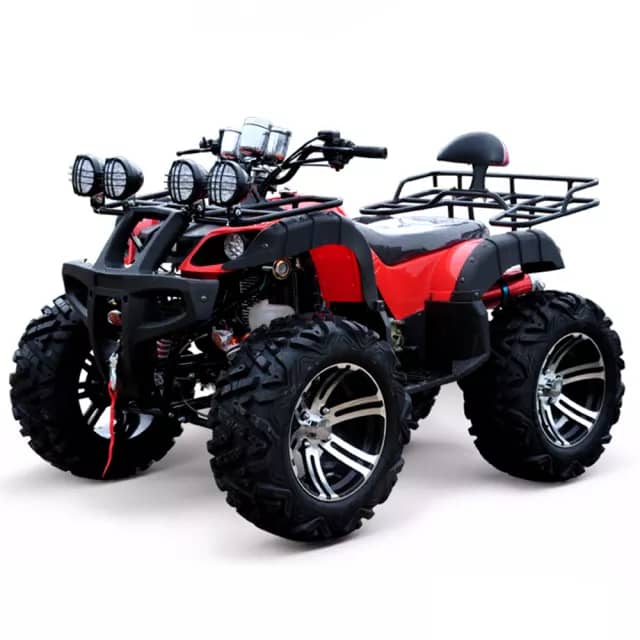Utility ATVs: Why They’re a Game-Changer — and How Cadmoto Limited Is Leading the Pack



When we talk about utility ATVs (All-Terrain Vehicles) or quad bikes, many people first think “fun weekend ride”. But actually, their strongest value often lies in practical work, especially in challenging terrain, farms, estates, resorts, security patrols and off-road environments. This is especially relevant to the Nigerian context where terrain, infrastructure and mobility needs can vary a lot.
And this is where Cadmoto Limited steps in offering solid utility ATV solutions tailored for Nigeria. In this post, we’ll cover what utility ATVs are, why they matter, and how Cadmoto’s offering makes a difference.
What is a Utility ATV?
Utility ATVs differ from sport-ATVs in that they are built with work and function in mind, not just speed and thrills. Key features include:
- Larger engine sizes (often 250 cc and above) to handle heavier loads and tougher terrain. (cadmoto.com)
- Tow hitches, cargo racks, trailer attachments or mounts for tools / sprayers. (Nairaland)
- Strong suspension, durable frames and good tyres for rough ground — which is common in agricultural or estate settings. (cadmoto.com)
- Versatility: can be used for farming, transport on narrow/tricky paths, patrol work, resort rentals, etc. (Nairaland)
In short: a utility ATV is a multi-purpose tool on wheels, especially valuable where standard vehicles struggle.
Why Utility ATVs Matter in Nigeria
Here are a few reasons the concept is especially relevant:
- Terrain & accessibility: Many farms, estates, construction sites or security zones in Nigeria have rough, non-paved roads, narrow tracks or areas inaccessible to regular cars. Utility ATVs can navigate these. (Nairaland)
- Productivity & cost-efficiency: Using an ATV instead of moving tools, workers, materials by foot or inefficient methods saves time and effort. For example: transporting feed, tools, patrols, harvest within a large farm. (Nairaland)
- Versatility of use: One machine can serve multiple roles—farm work in the morning, security patrol in the afternoon, leisure ride on weekends. This helps maximise return on investment.
- Localised support & logistics: Because companies like Cadmoto provide local assembly/parts/delivery, it becomes more feasible to maintain these vehicles reliably in Nigeria. (cadmoto.com)
How Cadmoto Limited is Making a Difference
Here are specific ways Cadmoto stands out in this space:
1. Tailored Models & Features
- Cadmoto offers engine size ranges from beginner levels (150-200cc) up to full utility sizes (300-450cc+) which match farm, estate or commercial use. (cadmoto.com)
- They provide both petrol and electric variants, including models built for “heavy‐duty work” rather than just play. (cadmoto.com)
- Their machines include features suited for Nigerian terrain: automatic F-N-R transmissions, rugged tyres, alloy wheels, hydraulic brakes, and options for towing and racks. (cadmoto.com)
2. Localised Support & Nationwide Reach
- They operate out of Lagos but deliver across Nigeria so you’re not restricted by geography. (cadmoto.com)
- They emphasise spare parts, servicing, and maintenance support critical for utility machines used in demanding settings. (cadmoto.com)
- Transparent pricing and model breakdowns (something not always available in this market) help buyers make informed decisions. (cadmoto.com)
3. Use‐Case Knowledge
- Cadmoto explicitly addresses use cases relevant to Nigeria: agriculture (farm tools, patrols, spraying), security, tourism/resorts, rugged terrain. (Nairaland)
- They also guide on “how to choose the right ATV” based on engine size, type (electric vs petrol) and usage. For example: 300-500cc is ideal for “general utility and trail riding”. (cadmoto.com)
How to Choose & Use a Utility ATV (With Cadmoto in Mind)
Here are actionable tips if you’re considering buying a utility ATV through Cadmoto:
- Define your primary usage: Will it mostly be farm work (tools, build, harvest), estate patrol, recreational? This defines engine size, features, 4×4 vs 2×4, etc.
- Pick the appropriate engine size: For heavy utility use (towing, rough terrain), Cadmoto recommends 300-500cc. For lighter tasks, 150-250cc may suffice. (cadmoto.com)
- Decide fuel type: Electric offers quiet, low-maintenance use (great for resorts, estates), but petrol will often give longer range and more power for remote/rough work. Cadmoto offers both. (cadmoto.com)
- Ensure relevant features: Cargo racks, tow hitch, strong tyres, good suspension. If you’ll carry tools, trailers, or move across rough terrain, make sure your model has these capabilities.
- Check after-sales & parts availability: Cadmoto emphasises spare‐parts support and maintenance. Make sure you get clarity on service intervals, warranty, local parts.
- Budget & delivery: As of mid-2025, Cadmoto pricing gives you a benchmark: e.g., 250cc models around ₦4.5–5 M; 300-450cc models around ₦8.5–9 M. (cadmoto.com)
- Plan for usage & storage: An ATV used for work will face more wear & tear than a casual rider machine make sure you have safe storage, maintenance plan, and consider attachments you might need (trailers, sprayers, racks).
Final Thoughts
Utility ATVs: they are powerful tools in the right contexts, especially in settings like farms, estates, security zones or off-grid terrain. And when you partner with a provider like Cadmoto Limited—which understands local conditions, offers tailored models, delivers nationwide, and supports after‐sales you’re giving yourself a better chance of long‐term value and reliability.
